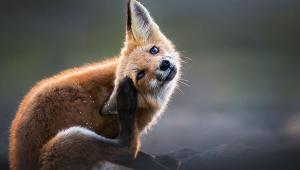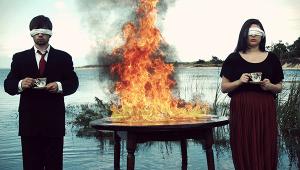Classic cars, they looks so amazing. Amazing shooting, I would appreciated the photography. Superb.
moving company queens
Pro's Choice: Peter Dawson Takes Cars On The Road: Meeting The Unique Challenges Of Shooting Cars Outdoors
Philippe Halsman, in his book Halsman on the Creation of Photographic Ideas, talked about an ad he’d shot, where he had to show a car making a splash as it was driving through a water-filled trough. But rather than give it the traditional treatment of the day, he sought to make a real splash with the picture, so he lit it differently. Shooting at dusk, he positioned flashbulbs so they hit the “wings,” as he called them, from each side. Like Halsman, photographers specializing in automotive are finding ways of introducing unusual and unique twists to make the shot stand out. Peter Dawson is one such automotive photographer who takes a particularly keen interest in dealing with challenges outdoors, on location.
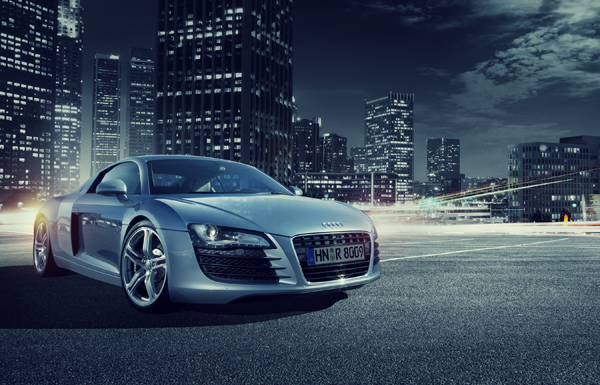
Using a Canon EOS 5D Mark II with a 24-70mm lens (at 35mm), Peter Dawson photographed this Audi R8 in a parking lot, in late evening, adding the Los Angeles vista in post. Dawson morphed sunlight into moonlight for this subdued nighttime effect. An assistant moved a Profoto head around, illuminating the grille, front corner, and tire. All these added elements (separate exposures) were then composited into the final image. (Art Director: Nate Luzod.)
All Photos © Peter Dawson
Los Angeles based, Dawson studied photography at Brooks Institute and found himself shooting for the music and entertainment industries after a short stint as an assistant. One of his passions had been landscapes, and, when he started to show this work to potential clients, they suggested these landscapes would make very convincing backdrops for cars shot on the road. So in 2007, Dawson began shooting cars for editorial and advertising clients, while using his continually growing library of backdrops to lend these shots a defining atmosphere.
Camera Gear Of Choice
In school, Dawson shot with a Nikon and 4x5 Horseman. But he soon gravitated to medium format, renting a Contax 645 for jobs. He still used the Nikon for portraiture.
“I transitioned to digital shortly after I started shooting cars. Automotive photography requires a lot of postproduction, layering numerous files to bring out various aspects in a vehicle. Film proved too costly and time-consuming. So I switched to a Canon EOS 20D at the time.” Now Dawson works with an EOS 5D Mark II for editorial and low-budget advertising shoots. With the 5D Mark II, he uses a 50mm f/1.2L and a 24-70mm f/2.8L.
For his big-budget advertising work, Dawson shoots with a Phase One P 45+ or P 65+, on either a Hasselblad or Phase One body, converting Raw files in Capture One. Lenses for medium format are the 80mm and 50mm. “On big jobs, we work with a production company and digital tech, who brings the camera, back, lenses, and computer to the job site. The digital tech is also in charge of making sure all this gear is properly set up, and he manages the files as we’re shooting.”

“You have to discuss the shot with the driver ahead of time, planning out the speed and relative position of his car and the car I’m shooting from.” Dawson shot this Lamborghini on an open road in the Mojave Desert, Nevada. “I’m in the back of an SUV, shooting out the open window. You need a long-enough exposure to get the motion but not too long to where it gets blurry. I found that shooting at 1/60 to 1/125 sec and moving at 40 to 50 mph keeps the car in sharp focus while giving the impression of movement (blurring) in the road and backdrop.” (Art Director: Nate Luzod.)
Available Light Plus Strobe
Because electricity is unavailable at most sites, Dawson largely relies on battery-powered Profoto Pro-7b systems, which he rents. “I shoot with a lot of natural light, mixing strobes in to highlight certain parts of the car.” He adds: “I use Profoto white beauty dishes with grids frequently to highlight tires and anything that’s not just metal.” You won’t find a softbox or umbrella on his sets.
“Every once in a while I’ll use a 6-foot Kino Flo single tube fluorescent at night to add a linear highlight to paint in lines in a car.” That requires a Honda generator. And every so often he’ll pop a Canon shoe mount if he just needs a subtle hint of light. HMI lighting is rare because “it’s a hassle, and just unnecessary for the most part.” On the one or two occasions Dawson did use HMIs, it was to light an expansive backdrop that was essential to the shot as part of the original ambiance of the set. “Sometimes I’ll use a 4x8-foot white card for certain sections of chrome on the car, especially the grille.”
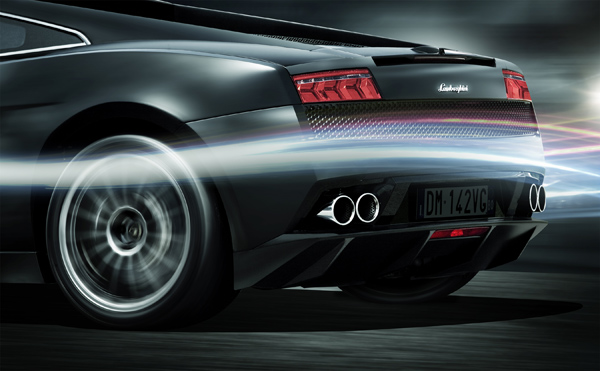
Dawson came up with this idea, first shooting the Lamborghini during the day at the Las Vegas Motor Speedway using strobe to overpower daylight and highlight various features. At night, his assistant drove the rental SUV back and forth, with lights on during a long exposure, which was later composited into the shot. Why focus on the back of the car? “Just for a different viewpoint. So much of the time you’re seeing the whole car and the shots tend to be very similar.” The Lamborghini was stationary; the wheel spin and motion blur were applied in post. (Art Director: Dan Delaney; Agency: Redwood, London.)
On Location
Whether it’s an advertising or editorial shoot, the client generally comes to the table with a concept and a location in mind, notes Dawson. “Land Rover really likes to show their vehicles tackling challenging terrains, while still appearing stylish and refined. On one shoot we were in the Chihuahuan Desert in New Mexico, and Kodiak Island, Alaska, on another. I’ve also shot Ferraris in Central Italy, which was fun.
“On editorial shoots, they’ll give you a visual treatment and a description of what they’re looking for. In cases where I’ve previously worked with an AD, he may leave me to my own devices. With commercial and advertising, there’s always an AD looking at everything and you’re making decisions together on what to do.”
Dawson notes: “Being able to communicate each step along the way is vital so that all involved are on the same page. I have found that being a good retoucher has helped me immensely in being able to assemble quick composites on set, and that helps us all communicate more effectively.”
Advertising jobs are routinely shot with the camera on a tripod, either a Gitzo or Manfrotto, when the car is stationary. When the car is moving, the camera goes on a carbon-fiber rig—to show motion. The rig consists of a long arm to which the camera is attached. A production company is responsible for attaching the rig so that it’s not visible in the frame (a tiny bit perhaps, but retouching takes care of that). Setting the camera on a tripod beforehand helps establish the shooting angle for when the camera is moved to the rig, where it remains fixed in place.
“The rig is so solidly constructed that the camera stays in perfect relation to the car. The thing is that the car is not going 30 mph—it’s literally moving at a crawl or being pushed. The car might move a total of 3 or 4 feet during a 4- or 5-second exposure.”
For editorial, Dawson may sometimes shoot car to car, in which case the camera is handheld, with one vehicle pacing the other.

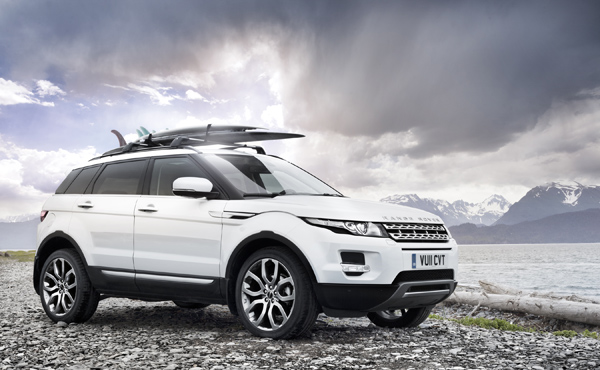
Many assignments require various perspectives and locations. “The story was about a surfing road trip along the Alaska Highway, to the coast, and eventually Kodiak Island (for the shot with the surfer), looking for the best and most remote surfing spots in the state. We were on the road for nearly three weeks, capturing everything from the car to wildlife, landscapes, surfing action, and people we met along the way. For this shot, we pulled the car, a Range Rover Evoque, right up onto the beach.” Shooting largely by available light, Dawson did use one pop of a Canon flash for the back of the vehicle. He bracketed exposures, to capture detail throughout, blending them in post. The second shot was made entirely by natural light, bracketed to get detail in the white paint as well as the shadows and tires. “It was shot in late evening near Anchorage while we were waiting for a ferry boat. The concept was to get a beauty shot with some snow in the background to represent Alaska. The sky was added in post.” (Art Director: Dan Delaney; Agency: Redwood, London.)
Some Tips
Dawson offers this advice: “When shooting car to car, the main challenge is finding a smooth stretch of road to minimize vibrations in the car and in my camera, while still making the shot visually appealing, with a good background. The other challenge with shooting motion car to car (instead of on a rig) is finding the right combination of car speed and shutter speed. This combination allows the road to blur nicely and the wheels to spin, but minimizes any other vibration which would make the car appear blurry. Using as wide a lens as possible also helps.
“On advertising shoots a challenge I often run into is that the angle of the car in the shot is often set and unwavering, and that dictates focal length. Once we have the art director’s approval, the camera is locked in place. That also goes for the lighting. And when natural light is involved, you have to literally predict where the light will be when you start shooting.”

For this advertising campaign, the client had a specific concept, mood, lighting, and color scheme in mind. The production company managed the rented space, blocking it off to traffic with acquired permits. The car is moving, but very slowly, with the camera attached to it via a rig. Parts of the image were shot with the camera tethered to a computer, and parts went straight to card. “The reason for this is twofold: sometimes we will do exposures where the car is moving a greater distance than is convenient for tethering. And often when one camera is locked in position on the rig and tethered, I will use a second camera to shoot different pieces of the location that will be used in the final image (such as another section of the overpass). For these shots it’s nice to be mobile, not tied to a computer.” A Profoto Pro-7b with bi-tube (plugged into two packs for the required power) augmented the available light. (Art Director: Nik Piscitello; Art Buyer: Jason Lau; Creative Director: Jason Stinsmuehlen; Agency: Team One, Los Angeles.)
To see more of Peter Dawson’s work, visit www.peterdawson.net.
- Log in or register to post comments


Impressive tips that is surely useful for newbie car photographers. I like that shot where the car looks really moving. - KSA Kosher












